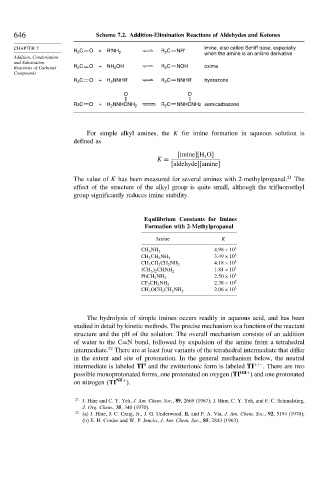Page 664 - Advanced Organic Chemistry Part A - Structure and Mechanisms, 5th ed (2007) - Carey _ Sundberg
P. 664
646 Scheme 7.2. Addition-Elimination Reactions of Aldehydes and Ketones
CHAPTER 7 imine, also called Schiff base, especially
R 2 C O + R'NH 2 R 2 C NR'
when the amine is an aniline derivative
Addition, Condensation
and Substitution
Reactions of Carbonyl R 2 C O + NH 2 OH R 2 C NOH oxime
Compounds
R 2 C O + H 2 NNHR' R 2 C NNHR' hydrazone
O O
R2C O + H 2 NNHCNH 2 R 2 C NNHCNH2 semicarbazone
For simple alkyl amines, the K for imine formation in aqueous solution is
defined as
imine H O
2
K =
aldehyde amine
The value of K has been measured for several amines with 2-methylpropanal. 21 The
effect of the structure of the alkyl group is quite small, although the trifluoroethyl
group significantly reduces imine stability.
Equilibrium Constants for Imines
Formation with 2-Methylpropanal
Amine K
4 98×10 3
CH 3 NH 2
3 49×10 3
CH 3 CH 2 NH 2
4 18×10 3
CH 3 CH 2 CH 2 NH 2
1 84×10 3
CH 3 2 CHNH 2
2 50×10 3
PhCH 2 NH 2
2 38×10 2
CF 3 CH 2 NH 2
2 06×10 3
CH 3 OCH 2 CH 2 NH 2
The hydrolysis of simple imines occurs readily in aqueous acid, and has been
studied in detail by kinetic methods. The precise mechanism is a function of the reactant
structure and the pH of the solution. The overall mechanism consists of an addition
of water to the C=N bond, followed by expulsion of the amine from a tetrahedral
22
intermediate. There are at least four variants of the tetrahedral intermediate that differ
in the extent and site of protonation. In the general mechanism below, the neutral
0
intermediate is labeled TI and the zwitterionic form is labeled TI +/− . There are two
possible monoprotonated forms, one protonated on oxygen (TI OH+ ) and one protonated
on nitrogen TI NH+ .
21 J. Hine and C. Y. Yeh, J. Am. Chem. Soc., 89, 2669 (1967); J. Hine, C. Y. Yeh, and F. C. Schmalstieg,
J. Org. Chem., 35, 340 (1970).
22
(a) J. Hine, J. C. Craig, Jr., J. G. Underwood, II, and F. A. Via, J. Am. Chem. Soc., 92, 5194 (1970);
(b) E. H. Cordes and W. P. Jencks, J. Am. Chem. Soc., 85, 2843 (1963).

